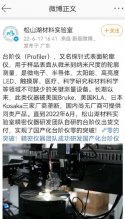The anti-radiation chip of the Institute of Microelectronics helps the construction and operation of the Chinese space station
On November 3 , 2022 , the Mengtian experimental module of the space station successfully completed its relocation, marking the official completion of the basic configuration of the " T " character of the Chinese space station. On November 12 , the Tianzhou-5 cargo spacecraft quickly rendezvoused and docked with the Tianhe core module of the space station, and the space station entered the long-term on-orbit operation stage. During the construction and future operation of the space station, microelectronics has provided strong support in terms of radiation-resistant core chips. Eight radiation-resistant chips , including KW064 , KW8Q512K8 , KW54HCS164 , KWJCTRCS7426 , and KWRCS7382 , developed by the Key Laboratory of Radiation -resistant Device Technology The application in the core payload of the space station helps the construction and operation of the space station. The Institute of Microelectronics is the backbone R&D institution of radiation-resistant chips in China. The key laboratory of radiation-resistant device technology has been engaged in the research of radiation-resistant hardening technology for a long time . Developed a variety of anti-radiation 0.35-0.13 micron SOI CMOS technology based on independent intellectual property rights , pedigree anti-radiation chip products, the anti-radiation index has reached the international advanced level, and related achievements have won 2 provincial and ministerial awards .

SMEE Lithography machines are an overkill for this kind of applications. Anything else more advanced has been fabricated in the past few years with low volume EUV machines and low volume Arf immersion machines.


SMEE Lithography machines are an overkill for this kind of applications. Anything else more advanced has been fabricated in the past few years with low volume EUV machines and low volume Arf immersion machines.





